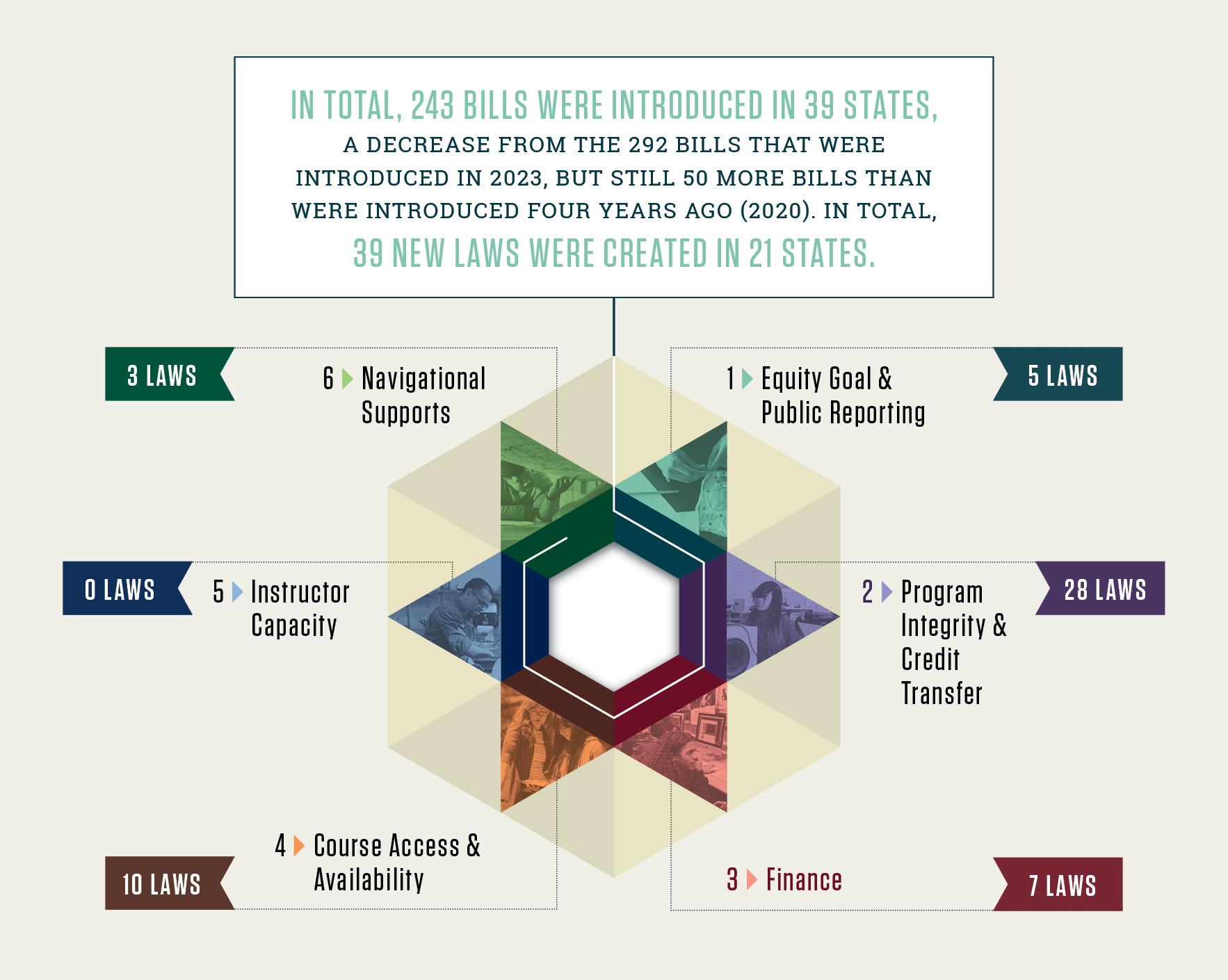In February 2025, CHSA released a 2024 Year in Review for its State Legislative Tracker. This policy resource summarizes the new state laws adopted in 2024, and summarizes the key trends.
Policies impacting college in high school programs such as dual enrollment, concurrent enrollment, and early college high school continued to be significant across the country in 2024, though the overall number of bills introduced decreased in 2024 over 2023, as did the number of bills that became law. In total, 243 bills were introduced in 39 states related to college in high school programs, a decrease from the 292 bills that were introduced in 2023, but still 50 more bills than were introduced four years ago (2020). In total, 39 new laws were created in 21 states.
Using the College in High School Alliance’s framework for state policy explained in Unlocking Potential: A State Policy Roadmap for Equity and Quality in College in High School Programs, breaking down the enacted laws by the six categories of the framework shows that the biggest areas of activity this year were in Course Access & Availability and Program Integrity and Credit Transfer.
Notable New Laws:
- California SB 153 - This law makes it easier for California dual enrollment students to access their course transcripts for dual enrollment, through requiring use of the eTranscript California platform.
- Connecticut SB 14 - Connecticut currently lacks significant state policy to support dual enrollment access and success in the state, and this law would authorize a study regarding the feasibility of establishing and administering a statewide program to allow students to participate in dual enrollment.
- Idaho SB 1359 - Idaho increased the funding available for eligible students in the Advanced Opportunities program to $4,625 (up from $4,125) to use towards postsecondary and career opportunities in high school, including dual credit.
- Tennessee HB 1923 - This law is designed to increase the matriculation of dual enrollment students to the institution of higher education who provided them with dual enrollment opportunities by requiring each Tennessee College of Applied Technology (TCAT) to reserve an enrollment slot for each dual enrollment student in the term immediately following the last term in which the student was enrolled in the TCAT as a dual enrollment student.
- Virginia SB 627 - This law establishes the College and Career Ready Virginia Fund and requires the Board of Education and State Board for Community Colleges to establish the College and Career Ready Virginia Program to expand access to dual enrollment for Virginia high school students statewide.
- Washington HB 1146 - This law requires each public school to provide students in grades 9-12 and their parents with information about each available dual credit program and any financial assistance available to reduce dual credit course and exam costs, to promote awareness and access to these opportunities.
Other Trends:
There was a decline in new dual enrollment laws in 2024 for the first year since 2020. Some of that may be attributable to the significant slate of new laws passed related to dual enrollment in the last several years; many states have implemented new laws and policies in the last several years related to dual enrollment, and need time to implement those laws and assess their impact before further policies can be considered.
The decline in new dual enrollment laws may also reflect the wider reality of state budgets and education policymaking in 2024. With the conclusion of many of the pandemic-era funding programs that provided significant financial support to K-12 and higher education, states have faced significant budget pressure to identify funding to continue many of the services, including education programs, that had been funded through these temporary programs. The result has been, across the board, a more challenging environment for new education policy and funding, and this may have also impacted the amount of new policymaking for 2024. These trends are likely to continue in 2025.
Summaries of each of the new laws impacting college in high school programs are included in the full resource. For summaries and more information about all of the bills introduced in 2024, visit the College in High School Alliance’s State Legislative and Regulatory Tracker. The database will continue tracking all new bills and regulatory actions in 2025.


